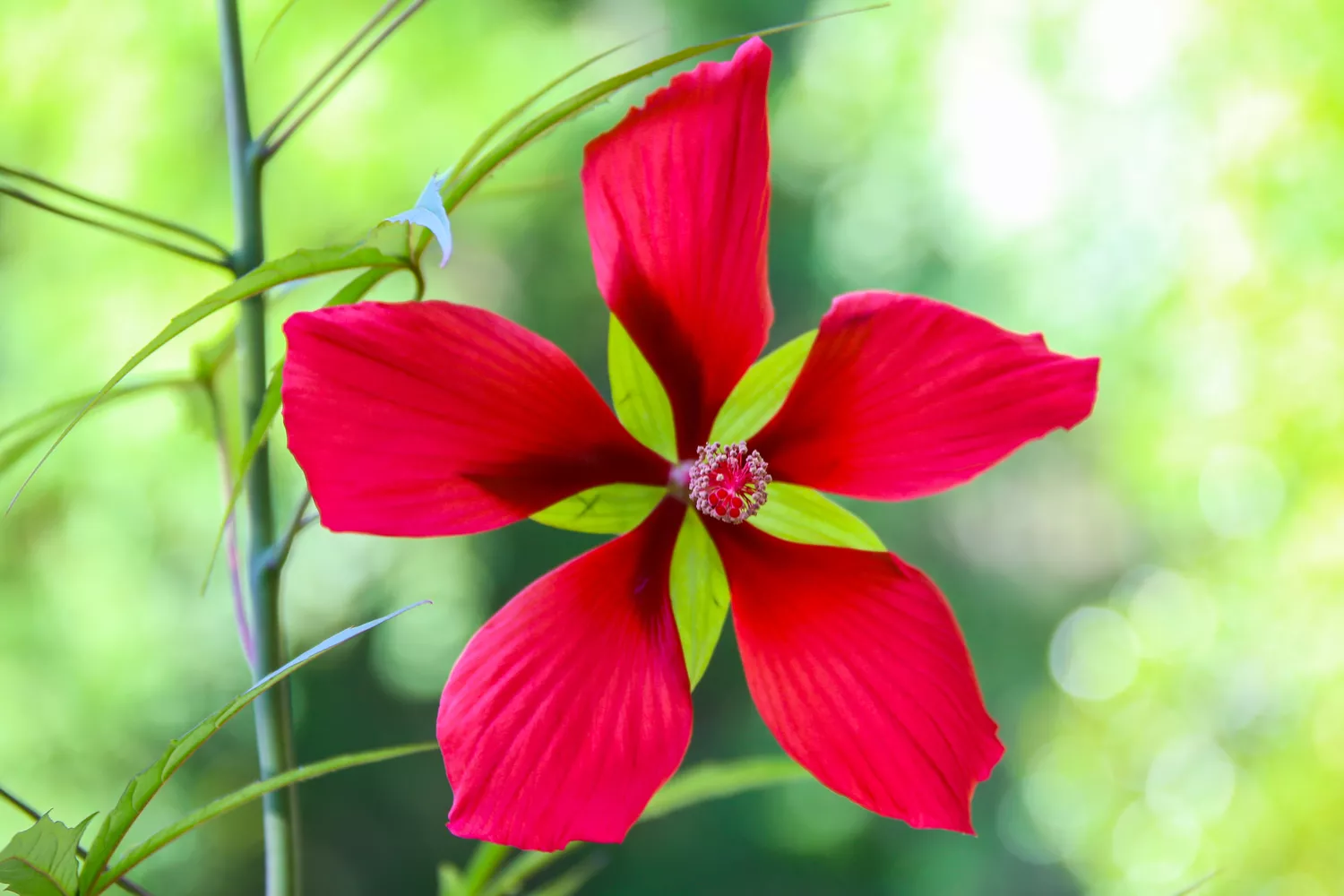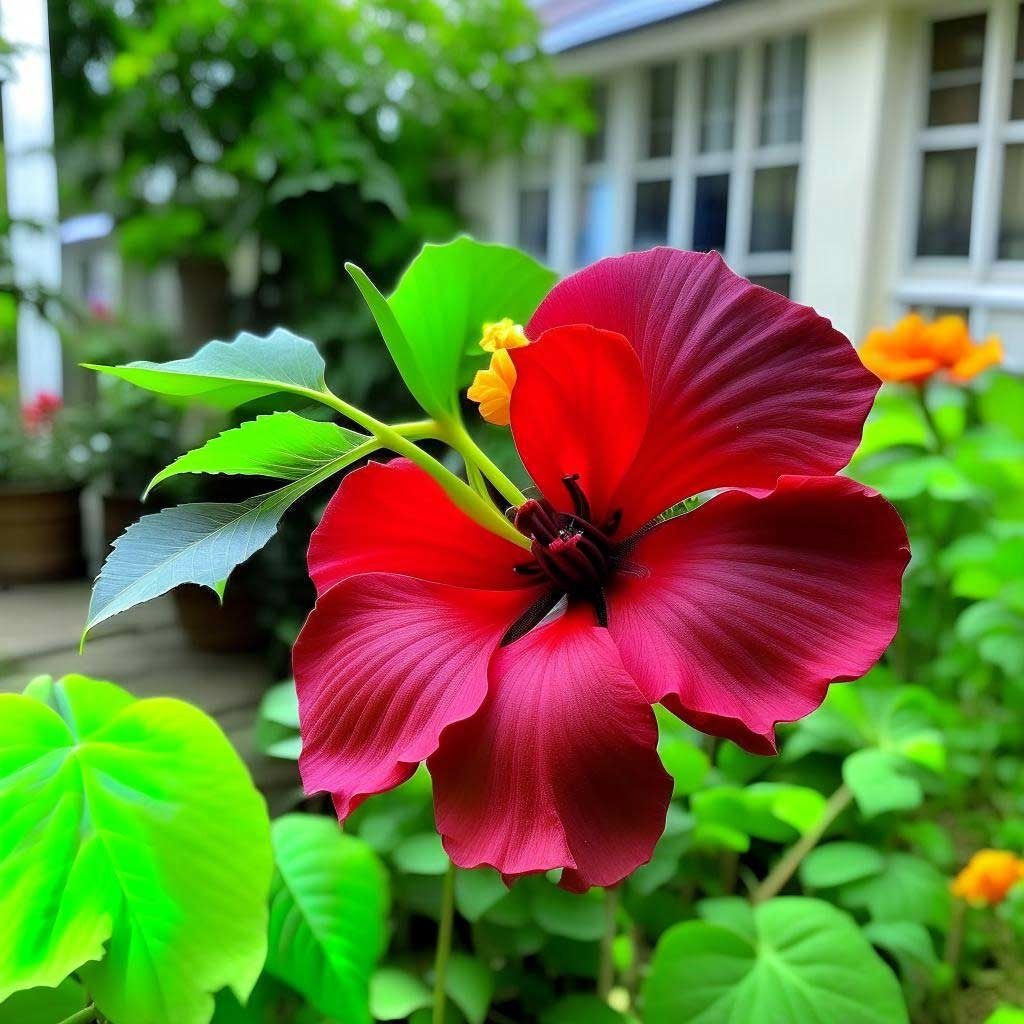
With large scarlet blooms, Texas Star hibiscus brings a lush, exotic feel to the garden without the drawbacks of short-lived, non-native tropical varieties. Texas Star hibiscus blooms mid-summer into fall. Its striking red flower petals grow to six inches wide and are cut deeply and finer than other hibiscus. In the center, dramatic yellow stamens entice pollinators. Texas Star features five-petaled, palmate leaves with deep red stems ideal for adding interesting landscape structure in addition to the blooms. Its tropical-like flowers attract bees, butterflies, and hummingbirds.
Unlike tropical hibiscus varieties native to Hawaii and similar climates, Texas Star is an herbaceous perennial, returning year after year in USDA Zones 5-9. It can tolerate all but the harshest freezes to return from the root in late spring.
Plant Attributes
| Common Name | Texas Star Hibiscus, Scarlet Rose Mallow, Wild Red Rose Mallow, Swamp Mallow |
| Botanical Name | Hibiscus coccineus |
| Family | Malvaceae (Mallow) |
| Plant Type | Herbaceous Perennial |
| Mature Size | 6 to 8 ft. tall, 2 to 3 ft. wide |
| Sun Exposure | Full sun, Partial shade |
| Soil Type | Moist to Wet |
| Soil pH | 6.0 – 6.5 |
| Bloom Time | Summer |
| Flower Color | Scarlet |
| Hardiness Zones | USDA Zones 5-9 |
| Native Area | Southeastern United States |
Care
In the right conditions with full sun and moist soil, showy Texas Star hibiscus can thrive year after year, adding drama to the landscape with showy scarlet blooms. Plant in a well-drained bed with several inches of mulch to help retain moisture. Supplemental watering may be necessary in hot and dry periods. To support prolific blooming through the growing season, fertilize once a month summer to fall. Texas Star can also be grown in containers with adequate water and fertilizer.
Light
Texas Star is a vigorous grower, thriving in full sun. It will grow in part shade but may bloom less or become leggy, requiring more pruning to encourage fullness.

Soil
Texas Star hibiscus grows in most moist and well-drained soil that is slightly acidic. It grows well in sand or near swampy areas. To help keep the soil evenly moist, use several inches of mulch.
Water
Found naturally in roadside ditches, marshes, and other wet areas, Texas Star hibiscus loves wet feet. Keep soil moist throughout the root zone. You cannot overwater this plant in the garden. It will adapt to drier conditions, though may need supplemental water in hot, dry summers. It is an excellent plant for bog or rain gardens.
Temperature And Humidity
The summer heat and high humidity in Southern coastal states doesn’t faze this hibiscus.
Fertilize
To encourage continual blooming, apply a balanced fertilizer blend once a month through the growing season, spring through summer.
Pruning
Pruning isn’t required, though you can shape as you would like. The showy blooms last one day and are replaced with a profusion of new blooms each day. If you like, you can pinch off spent blooms as new ones appear, but deadheading isn’t necessary.
Propagating
Propagate from tip and stem cuttings in spring. Dip five to six-inch cuttings into rooting hormone. Press cuttings three inches into a container filled with damp peat moss. Avoid direct sunlight. Transplant it into the garden when leaves begin to develop.
How To Grow From Seed
Texas Star is easily grown from seed. After pods have dried and turned brown, pop open pods and collect seeds. Store in envelopes until spring. Sow indoors in starter trays using seed starter mix and keep soil warm and evenly moist. After the danger of frost has passed, you can plant seeds directly outside or transplant seedlings into the garden. Texas Star may also self-sow in the garden.

Overwintering
No need to overwinter Texas Star. The plant will go dormant and die back until spring. Cut back to within four to six inches of the ground in spring as new growth appears.
Common Pests And Diseases
Texas Star is susceptible to grasshoppers, aphids, Hibiscus whiteflies, mealybugs, thrips, and scale. You can spray water on the plant to dislodge pests or spray with insecticidal soap. Another option is to treat both top and undersides of leaves with horticultural oil.





